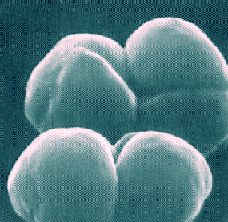
The Campylobacterales are an order of Campylobacterota which make up the epsilon subdivision, together with the small family Nautiliaceae. They are Gram-negative. Most of the species are microaerophilic.
The Thermoprotei is a class of the Thermoproteota.

Desulfovibrionales are a taxonomic order of bacteria belonging to the phylum Thermodesulfobacteriota, with four families. They are Gram-negative. The majority are sulfate-reducing, with the exception of Lawsonia and Bilophila. All members of this order are obligately anaerobic. Most species are mesophilic, but some are moderate thermophiles.
The Syntrophobacterales are an order of Thermodesulfobacteriota. All genera are strictly anaerobic. Many of the family Syntrophobacteraceae are sulfate-reducing. Some species are motile by using one polar flagellum.

The Hydrogenothermaceae family are bacteria that live in harsh environmental settings. They have been found in hot springs, sulfur pools, and thermal ocean vents. They are true bacteria as opposed to the other inhabitants of extreme environments, the Archaea. An example occurrence of certain extremophiles in this family are organisms of the genus Sulfurihydrogenibium that are capable of surviving in extremely hot environments such as Hverigerdi, Iceland.

The Leptospiraceae are a family of spirochete bacteria. It includes the genus Leptospira which contains some pathogenic species.

Thermoplasmataceae is a family of archaeans in the order Thermoplasmatales. It contains only one genus, Thermoplasma. All species within Thermoplasmataceae are thermoacidophiles, and they grow at a temperature of 60 °C and pH 2. They were isolated from hydrothermal vents, fumaroles and similar environments.

The Propionibacteriaceae are a family of Gram-positive bacteria found in dairy products or in the intestinal tracts of animals and living in the pores of humans.
The Myxococcota are a phylum of bacteria known as the fruiting gliding bacteria. All species of this group are Gram-negative. They are predominantly aerobic genera that release myxospores in unfavorable environments.

In the taxonomy of microorganisms, the Methanomicrobia are a class of the Euryarchaeota.

The Acidobacteriaceae are a family of Acidobacteriota.
The Geodermatophilaceae are an actinomycete family of bacteria.
The Nautiliaceae are a family of bacteria placed in an order to itself, Nautiliales. The members of the family are all thermophilic.
Hippea is an obligate anaerobic and moderately thermophilic bacteria genus from the family of Desulfobacteraceae. Hippea is named after the German microbiologist Hans Hippe.
Phycisphaeraceae is a family of bacteria.
Planctopirus is a genus of bacteria from the family of Planctomycetaceae
Nautilia is a genus of bacteria from the family of Campylobacterota.
The Propionibacteriales are an order of bacteria.
The Opitutales is an order in the phylum Verrucomicrobiota.
The Opitutaceae are a Gram-negative and chemoheterotrophic order of the domain Bacteria. Opitutaceae bacteria were isolated from soil and coastal marine springs.







